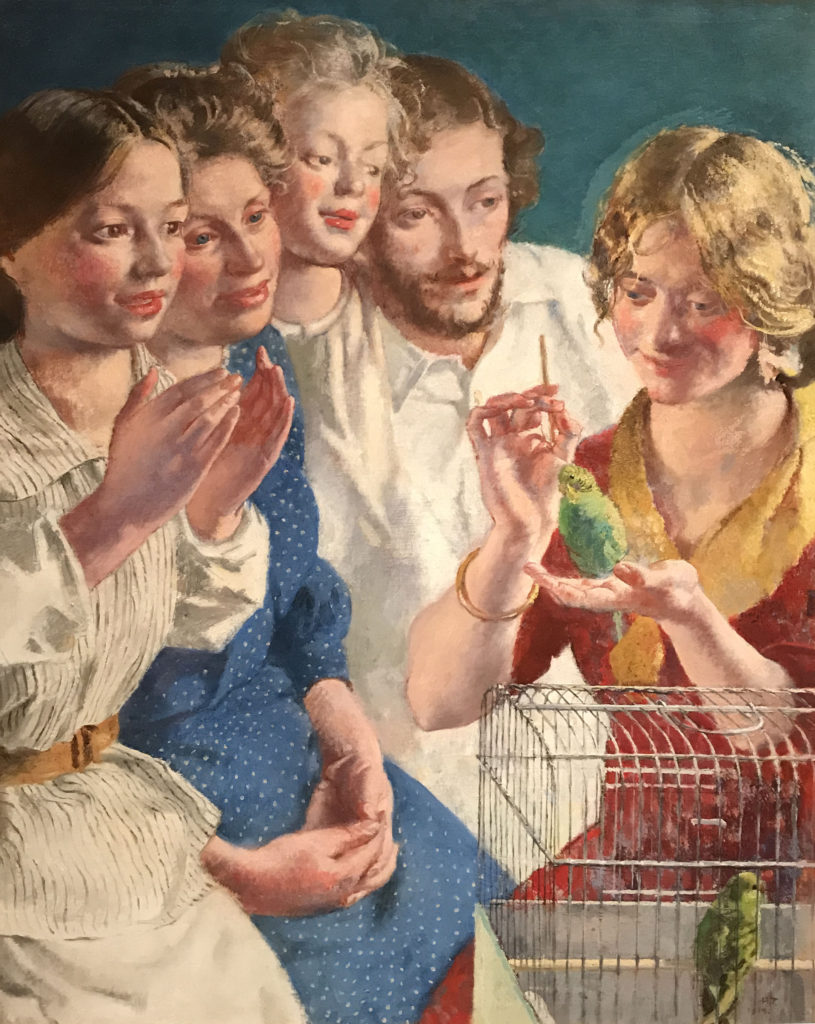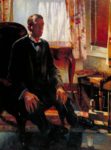
Henry Tonks
British, 1862-1937
The Fortune Teller, 1914
oil on canvas
SBMA, Gift of Mary and Jeffrey P. Tuck in honor of Mary and Will Richeson
2017.7

Portrait of the Artist, 1909, Henry Tonks was teaching at the Slade School of Art when he painted this self-portrait. As a teacher, Tonks placed a lot of emphasis on figure drawing, and here he puts this into practice by sitting next to a window to show the effects of light and shade on his face. His legs are positioned close to the viewer, enabling him to demonstrate the rules of foreshortening. Tonks was known to inspire terror in his pupils, and this is apparent from his sober clothing and stern expression, which are barely softened by the soft furnishings of the room.
SBMA CURATORIAL LABELS
Professor Henry Tonks played a formative role in the artistic development of several generations of young artists who trained at the famous Slade School at University College in London, which was first established in 1871. Tonks was convinced by Slade professor Frederick Brown to abandon the practice of medicine for which he was professionally trained as a surgeon, to become the school’s drawing professor. Under Tonks’ beady eye (he was legendary as an imperious, intimidating teacher), the Slade School of Art produced some of its most famous artists, including William Rothenstein, Augustus John, William Orpen, Paul Nash, Wyndham Lewis, Jacob Epstein, and David Bomberg. Tonks’ deep understanding of human anatomy made him naturally sympathetic to a more academic approach, including the copying of plaster casts and drawing from the live model. He was therefore also inevitably hostile to the “new” ideas introduced to his students by the likes of Roger Fry and Clive Bell, who promoted the radical alternatives of Cubism, Fauvism, and Expressionism, which they introduced in an important exhibition at the Grafton Galleries in 1910. Even though much of the art, by the likes of Picasso, Matisse, Cézanne, Manet, Gauguin, and van Gogh, was already decades old, it was entirely new to aspiring younger British artists, such as the so-called “Coster Gang,” which included Mark Gertler, Christopher Nevinson, Stanley Spencer, and Adrian Allinson.
As a practicing artist, Tonks is less well known, though he painted and exhibited work throughout his lifetime. One of his best known techniques was known as “tonking,” which entailed using paper or cloth impressed to the canvas to blot up any unwanted mistakes to allow for correction. This painting, which he chose to exhibit at least once in 1914, is typical of the kind of figurative genre scene that appealed to his sensibility. A family huddles around a fortune teller, as she coaxes a lime green parakeet into predicting their futures. In 19th-century England, street markets often featured such soothsayers, who enlisted birds, especially breeds susceptible to mimicry of the human voice like budgerigars, as a means of revealing one’s fortune. The provenance of the painting is distinguished; it once belonged to the publisher, Geoffrey Blackwell, who amassed a substantial collection of work by the best artists of the Slade School. The Fortune Teller is a fitting addition to the many works of British modernism already gifted to SBMA by the Richeson family and is the first work of art by Tonks to enter the permanent collection. The art of Tonks is well represented in British museums, such as the Tate, which has 12 paintings and drawings by the Professor. He is less well represented in American museums, like so many of the other major figures of British Modernism so sagely collected by the Richeson family. SBMA is indeed a rare resource in this regard, largely due to the Richesons’ extraordinary generosity.
- SBMA Summer Newsletter, 2017
